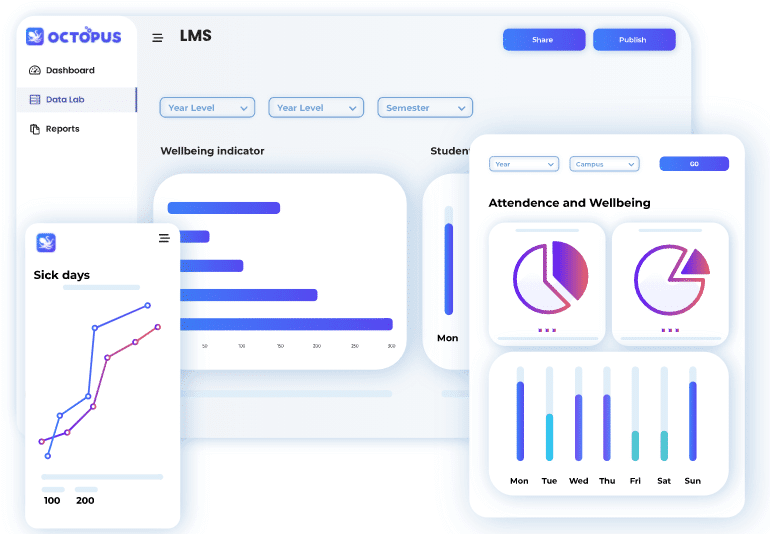Traditionally, educational institutions have employed manual methods of analyzing student data to flag possible at-risk students. This manual analysis relied upon a fairly narrow analysis of a student’s history, behavior and performance, took a great deal of time, and often failed to provide insights in time to intervene in a student’s expected outcomes and achievement.
Enterprises have used big data to predict and assess financial and employee-related risk for a long time. Now that educational institutions are investing in learning analytics and data collection, they too can benefit from using data analytics to improve learning and teaching environments.
Learning analytics is defined as the collection, measurement, analysis and reporting of data about learners and their contexts. Once data is analyzed and reported using learning analytics tools and software, educators and stakeholders can then optimize the learning environment for students in a much more personalised way, using evidence about what works to navigate the best path forward. As we like to say: the data is not the solution. Data helps you find the solution.
1. Learning analytics helps schools make decisions with evidence
Learning analytics software makes the perfect tool for an educator to make strategic, timely decisions for their students using evidence partnered with their own instincts. Data that applies to student behavior and achievement can highlight areas in which a student is struggling, when and where that struggle began, and its expected outcome. This gives educators the chance to create personalised learning strategies to get a student back on track, especially if they have data on what kinds of interventions work best for that student.
On a wider scale, with a topic like course enrolment and drop-out rates, an institution can be better prepared and informed as to whether a course is worth running and whether students are performing as expected within it. This can lead to the opportunity for curriculum or instructor improvement to better serve student needs.

2. Learning analytics helps schools set benchmarks
There is a global concern about student learning outcomes and achievement in the wake of the COVID-19 pandemic, but also in the advent of the online learning era. Learning analytics in education are an excellent tool for learning designers in setting expected student outcomes and achievement in a particular course. Once benchmarks have been set, learner analytics can then be used to assess current and future student progress.
Schools have always wanted to be better able to measure and analyze students on a wide range of topics including risk and intervention. With education analytics software, that desire can become a reality. With mathematically-proven strategies to measure and predict student growth, educators are much more able to locate problems and barriers impeding that growth, and intervene in time to prevent failure, drop out or problems later in school or life.
3. Learning analytics can be integrated with a school’s LMS and SIS
Quantitative markers that correlate with students’ final performance are wide-ranging. This is why it benefits institutions to unite their data sources in one dashboard, so they do not have to crunch data across multiple sources to get a complete picture of learners and their contexts. Here are just a few factors that researchers have used to predict risk in students:
- How often students login to LMS and whether they view resources
- Time spent engaging with course material, reading, viewing videos, etc.
- Formative assessment, homework and quiz scores, including time to complete
- Interactions and communications with teachers and other students at different points in time
- Indicators of self-regulation and out-of-class behaviors, including use of after-school tutoring
- Traditional data such as demographics, enrolment status, and historical achievement
- Benchmark data from standardised testing eg. PAT, NAPLAN, EduTest which is often used to measure and predict student’s year-to-year growth change and inform a risk profile
Learning analytics software can use machine learning to analyze a huge amount of factors and identify monthly, weekly and daily trends at a glance. This then allows them to take impactful actions at speed.

4. Learning analytics can be an effective early warning system
By analyzing multiple data sources, researchers can predict final grades and identify at-risk students mid-course, giving enough time for educators and institutions to reach out to students to intervene and assist them before it’s too late. The earlier educators or institutions are aware of a student’s risk, the more likely they are to conduct successful interventions, especially as the rate of success increases with multiple interventions.
It is best that institutions begin their data journeys as early as possible, to make the most of mature and stable data. However, measuring risk is one of the few topics where learning analytics can be utilised with relatively simple, low-cost models, and still achieve a high rate of sensitivity and accuracy. Studies show that final performance could be predicted with only one-third of the semester elapsed, or even just one week of the right kind of data (the first three factors in the list above).
You don’t need to break the bank to get started with predicting and helping at-risk students – but more data and more time will improve your results and chances of predictive success.
5. Learning analytics helps identify & use intervention wisely
Learning theories about intervention and risk management can be implemented much more effectively on a personalised, strategic, timely and proactive basis with the backing of learning analytics. Educators armed with evidence about what works for each child are better equipped to help in any given situation.
Intervention strategies can be simple, like automated feedback and resource emails triggered by predetermined behaviors or grade thresholds. Such intervention has long been practiced in traditional classrooms, but when you have 25-30 children in each classroom, it can be hard to pinpoint an individual child’s needs, weaknesses and struggles, as well as their learning styles and history of learning and achievement.
Learning analytics can provide teachers both in traditional and online classrooms with all of this information at any moment, so they can customize their interventions according to what that particular student needs. This is essential to ensuring no student falls through the gaps.

The benefits of learning analytics in predicting risk and intervention
Investing in predictive analytics creates a focus on personalised student learning outcomes, behaviors and achievements across a wide range of areas. It results in the potential for stronger curriculum development and improved instructor performance at the institutional level. It helps institutions save time and money, investing attention and resources where they can make a real difference.
In this era of personalized learning and digitized education, education institutions are expected to put strong emphasis on data-informed practices. This requires investment into getting actionable insights from their data to enable the best outcomes. Institutions need to ensure their data systems are set up in such a way that they can live up to their policies and expectations.
Data is not the solution, nor is analyzing data. But having data at your fingertips can be an incredible aid in solving problems and making strategic decisions in real time. We’ve seen it in business environments: it’s time to make sure schools can take advantage of this opportunity too.




